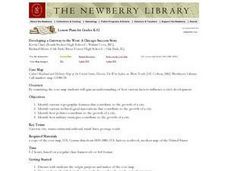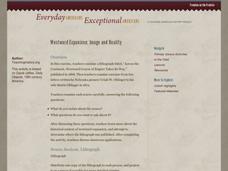Curated OER
The Golden Spike
Students investigate modern transportation in the 19th century by examining artifacts. In this U.S. history lesson, students read the story Joseph's Railroad Dreams, and discuss the Golden Spike used in the first transcontinental...
Curated OER
THE GAM SAAN ADVENTURE ARE YOU WILLING TO RISK IT?
Fourth graders study the lasting influence of the Pony Express, Overland Mail Service, Western Union, and the building of the transcontinental railroad, including the contributions of Chinese workers to its construction. They explore the...
Curated OER
Stop Action and Assess Alternatives
Students stop action and determine how history may have been altered. In this historical perspectives lesson, students consider how the Cherokee Removal, the Transcontinental Railroad, the Immigration Act of 1924, and the dropping of the...
Curated OER
Read a Transportation Story
Third graders research the building of a transcontinental road. In this railroad history lesson, 3rd graders discuss past and present transportation. Students look at historical photos and compare and contrast photos from today.
Curated OER
Developing a Gateway to the West
Students identify various topographical features that contribute to the growth of a city. They identify how military strategies contribute to the growth of a city.
Stanford University
Great Plains Homesteaders
"Westward, ho!" may have been their cry in spite of the hardships. Using a series of photographs by Solomon D. Butcher of those who ventured west, class members consider what life was like in the 1800s for those who embarked on the...
Roy Rosenzweig Center for History and New Media
Westward Expansion: Image and Reality
As your young historians study Westward Expansion, practice in-depth primary source analysis with the documents and guidelines presented in this resource. They will examine a lithograph and excerpts from two letters written by a Nebraska...
Curated OER
Using and Creating Timelines
Eleventh graders analyze information presented in a timeline and then create a time line. They put the following events in order from oldest to recent: Telephone invented (1876), Massacre at Wounded Knee (1890), First transcontinental...
Curated OER
Westward Expansion and the Frontier
Students explore U.S. history by researching a historic map. In this westward expansion lesson, students discuss the mystery of the western U.S. in the early 1800's and the impact expansion had on Native Americans and agriculture....
Curated OER
Robert Fulton and the Steamboat, "Trail of Tears"
Second graders study Fulton and his Steamboat, the "Trail of Tears," the Oregon Trail, the Transcontinental Railroad and the Pony Express in this series of lessons.
Curated OER
Dragon's Gate
Students read Dragon's Gate as a shared literature book. This lesson plan provides excellent extension activities students can engage in while they are reading, and after they have finished the book.
Curated OER
Causes of the Civil War: Missouri Compromise, Compromise of 1850 and Kansas Nebraska Act
How did the Missouri Compromise, the Compromise of 1850, and the Kansas-Nebraska Act contribute to the growing tensions that led to the Civil war? To better understand the events that led to the Civil War, young historians engage in a...
Curated OER
Why Do You Live Where You Do?
Eighth graders identify reasons why settlers bought land from the railroad and not a Homestead grant. Using that information, they compare and contrast the types of land given in each situation. They discuss the reasons why given...
Curated OER
The Chinese Expulsion Act of 1880
Students examine the Chinese Expulsion Act of 1880. In this History instructional activity, students explore the issues of immigration and exclusion surrounding the Chinese Expulsion Act. Students will use a variety of primary sources to...
Curated OER
Washington Irving in Context
Students examine the various roles Washington Irving had in his lifetime. Examining the situation in Europe and the United States, they are encouraged to relate Irving's experiences to different events. They examine themselves in many...
Stanford University
Chinese Immigration and Exclusion
Students investigate the 1882 Chinese Exclusion Act. In this Chinese immigration activity, students study evidence and develop hypotheses about reasons for Chinese immigration and exclusion. Students use a timeline and graphic organizers...
Curated OER
Rice Farming in Texas
Third graders explore how rice farming came to Texas. In this rice farming lesson, 3rd graders discover the history of how farmers began to grow rice in the United States. Students color code maps and create a timeline for rice farming...
Curated OER
California-Becoming an Agricultural and Insustrial Power
Fourth graders explain how California became an agricultural and industrial power. They trace the transformation of the California economy in its political and cultural development since the 1850's.
Curated OER
BEGINNER LEVEL LESSON PLAN
Students are be able to analyze primary sources (photographs) for evidence of Native American culture and construct a cultural symbol. They are explained what the stars and stripes stand for on the American flag. Students work as...
Curated OER
Cities as Transportation Centers
Young scholars work in small groups to identify some of the major transportation centers, recommending two as possible sites for a national political convention, based on population density and the travel networks available in 1835.
Curated OER
American Growth and Expansion in the late 1800s
Eleventh graders examine a picture of John Gast's, American Progress to determine what they know about American growth between 1877- 1900. By working through thirteen center or folder activities, they study the economics,...
Curated OER
The Gam Saan Adventure- Are You Willing to Risk it?
Students explain how California became an agricultural and industrial power, tracing the transformation of the California economy and its development since the 1850's.
Curated OER
Westward Expansion - Fur Trade
Students complete a unit of lessons to learn how products reach the market and study the history of the fur trade. In this history and trade lesson plan, students first learn about the technology that allowed products to reach market...
Curated OER
Where is Rice Grown?
Fifth graders create a timeline of the development of rice as an important crop. In this agricultural history lesson, 5th graders read about the history behind why rice was grown and where it is grown. Students demonstrate their learning...

























